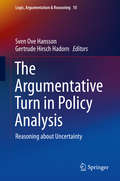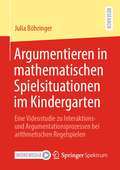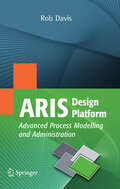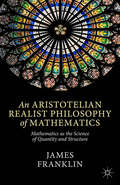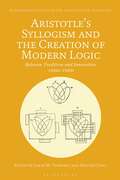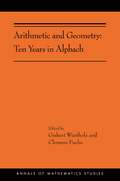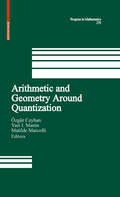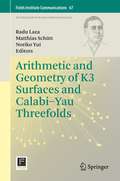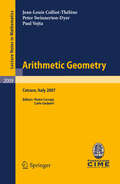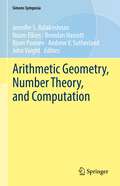- Table View
- List View
The Argumentative Turn in Policy Analysis: Reasoning about Uncertainty (Logic, Argumentation & Reasoning #10)
by Sven Ove Hansson Gertrude Hirsch HadornThis book describes argumentative tools and strategies that can be used to guide policy decisions under conditions of great uncertainty. Contributing authors explore methods from philosophical analysis and in particular argumentation analysis, showing how it can be used to systematize discussions about policy issues involving great uncertainty.The first part of the work explores how to deal in a systematic way with decision-making when there may be plural perspectives on the decision problem, along with unknown consequences of what we do. Readers will see how argumentation tools can be used for prioritizing among uncertain dangers, for determining how decisions should be framed, for choosing a suitable time frame for a decision, and for systematically choosing among different decision options. Case studies are presented in the second part of the book, showing argumentation in practice in the areas of climate geoengineering, water governance, synthetic biology, nuclear waste, and financial markets. In one example, argumentation analysis is applied to proposals to solve the climate problem with various technological manipulations of the natural climate system, such as massive dispersion of reflective aerosols into the stratosphere. Even after a thorough investigation of such a proposal, doubt remains as to whether all the potential risks have been identified. In such discussions, conventional risk analysis does not have much to contribute since it presupposes that the risks have been identified, whereas the argumentative approach to uncertainty management can be used to systematize discussions.
Argumentieren in mathematischen Spielsituationen im Kindergarten: Eine Videostudie zu Interaktions- und Argumentationsprozessen bei arithmetischen Regelspielen
by Julia BöhringerEinhergehend mit der zunehmenden Bedeutung frühkindlicher Bildung rückte in der mathematikdidaktischen Forschung auch die frühe mathematische Bildung in den Fokus. Ein Schwerpunkt liegt auf der Erforschung spielbasierter mathematischer Förderung und dabei entstehender Lerngelegenheiten. Ein Schlüssel zur Wissenskonstruktion beim mathematischen Lernen sind verbale und nonverbale Interaktionen und damit einhergehend auch Argumentationen, die als spezifische Form der Interaktion gelten. An diesem Punkt setzt die Studie an, die als Teilprojekt des von der Internationalen Bodenseehochschule (IBH) geförderten Projekts „Spielintegrierte mathematische Frühförderung (spimaf)" durchgeführt wurde. Julia Böhringer untersucht, wie sich Interaktions- und Argumentationsprozesse in mathematischen Spielsituationen unter Kindergartenkindern gestalten. Übergeordnete Ziele der qualitativen Studie sind die Erfassung und Beschreibung von strukturellen und inhaltlichen Aspekten der Interaktionen sowie die Analyse deren Qualität in Form von Argumentationstiefen. Insgesamt lassen die Ergebnisse darauf schließen, dass sich speziell konzipierte, arithmetische Regelspiele zur Anregung und Förderung von mathematischen Interaktionen und Argumentationen eignen.
ARIS Design Platform: Advanced Process Modelling and Administration
by Rob DavisFollowing on from Rob Davis’ successful introductory book, ARIS Design Platform: Getting Started with BPM, Rob now covers in detail some of the more advanced concepts of using ARIS Business Architect. This is a practical ‘how-to’ guide and contains tips, techniques and short cuts gained from practical experience and explains clearly how to use ARIS and why ARIS is a powerful tool for process modeling. Advanced concepts such as the following are presented in this reader-friendly and concise guide: - Matrix editor, - Find and query, - Model generation, - Method filters and method changes, - Templates and fonts, - Reports and semantic checks, - Macros, - Transformations, - Database administration, - User management. This easy-to-follow advanced text is a must have guide and reference for all users who want to increase their ARIS skills, and for those who need to undertake advanced model and database management.
An Aristotelian Realist Philosophy of Mathematics: Mathematics as the Science of Quantity and Structure
by J. FranklinMathematics is as much a science of the real world as biology is. It is the science of the world's quantitative aspects (such as ratio) and structural or patterned aspects (such as symmetry). The book develops a complete philosophy of mathematics that contrasts with the usual Platonist and nominalist options.
Aristotle's Syllogism and the Creation of Modern Logic: Between Tradition and Innovation, 1820s-1930s (Bloomsbury Studies in the Aristotelian Tradition)
by Lukas M. Verburgt and Matteo CosciOffering a bold new vision on the history of modern logic, Lukas M. Verburgt and Matteo Cosci focus on the lasting impact of Aristotle's syllogism between the 1820s and 1930s. For over two millennia, deductive logic was the syllogism and syllogism was the yardstick of sound human reasoning. During the 19th century, this hegemony fell apart and logicians, including Boole, Frege and Peirce, took deductive logic far beyond its Aristotelian borders. However, contrary to common wisdom, reflections on syllogism were also instrumental to the creation of new logical developments, such as first-order logic and early set theory. This volume presents the period under discussion as one of both tradition and innovation, both continuity and discontinuity. Modern logic broke away from the syllogistic tradition, but without Aristotle's syllogism, modern logic would not have been born. A vital follow up to The Aftermath of Syllogism, this book traces the longue durée history of syllogism from Richard Whately's revival of formal logic in the 1820s through the work of David Hilbert and the Göttingen school up to the 1930s. Bringing together a group of major international experts, it sheds crucial new light on the emergence of modern logic and the roots of analytic philosophy in the 19th and early 20th centuries.
Aristotle's Syllogism and the Creation of Modern Logic: Between Tradition and Innovation, 1820s-1930s (Bloomsbury Studies in the Aristotelian Tradition)
Offering a bold new vision on the history of modern logic, Lukas M. Verburgt and Matteo Cosci focus on the lasting impact of Aristotle's syllogism between the 1820s and 1930s. For over two millennia, deductive logic was the syllogism and syllogism was the yardstick of sound human reasoning. During the 19th century, this hegemony fell apart and logicians, including Boole, Frege and Peirce, took deductive logic far beyond its Aristotelian borders. However, contrary to common wisdom, reflections on syllogism were also instrumental to the creation of new logical developments, such as first-order logic and early set theory. This volume presents the period under discussion as one of both tradition and innovation, both continuity and discontinuity. Modern logic broke away from the syllogistic tradition, but without Aristotle's syllogism, modern logic would not have been born. A vital follow up to The Aftermath of Syllogism, this book traces the longue durée history of syllogism from Richard Whately's revival of formal logic in the 1820s through the work of David Hilbert and the Göttingen school up to the 1930s. Bringing together a group of major international experts, it sheds crucial new light on the emergence of modern logic and the roots of analytic philosophy in the 19th and early 20th centuries.
Arithmetic
by Paul LockhartPaul Lockhart reveals arithmetic not as the rote manipulation of numbers but as a set of ideas that exhibit the surprising behaviors usually reserved for higher branches of mathematics. In this entertaining survey, he explores the nature of counting and different number systems—Western and non-Western—and weighs the pluses and minuses of each.
Arithmetic Algebraic Geometry: Lectures given at the 2nd Session of the Centro Internazionale Matematico Estivo (C.I.M.E.) held in Trento, Italy, June 24-July 2, 1991 (Lecture Notes in Mathematics #1553)
by Jean-Louis Colliot-Thelene Kazuya Kato Paul VojtaThis volume contains three long lecture series by J.L. Colliot-Thelene, Kazuya Kato and P. Vojta. Their topics are respectively the connection between algebraic K-theory and the torsion algebraic cycles on an algebraic variety, a new approach to Iwasawa theory for Hasse-Weil L-function, and the applications of arithemetic geometry to Diophantine approximation. They contain many new results at a very advanced level, but also surveys of the state of the art on the subject with complete, detailed profs and a lot of background. Hence they can be useful to readers with very different background and experience. CONTENTS: J.L. Colliot-Thelene: Cycles algebriques de torsion et K-theorie algebrique.- K. Kato: Lectures on the approach to Iwasawa theory for Hasse-Weil L-functions.- P. Vojta: Applications of arithmetic algebraic geometry to diophantine approximations.
Arithmetic Algebraic Geometry (Progress in Mathematics #89)
by G. Van Der Geer F. Oort Joseph SteenbrinkArithmetic algebraic geometry is in a fascinating stage of growth, providing a rich variety of applications of new tools to both old and new problems. Representative of these recent developments is the notion of Arakelov geometry, a way of "completing" a variety over the ring of integers of a number field by adding fibres over the Archimedean places. Another is the appearance of the relations between arithmetic geometry and Nevanlinna theory, or more precisely between diophantine approximation theory and the value distribution theory of holomorphic maps. Research mathematicians and graduate students in algebraic geometry and number theory will find a valuable and lively view of the field in this state-of-the-art selection.
Arithmetic and Geometry: Ten Years in Alpbach (AMS-202) (Annals of Mathematics Studies #202)
by Gisbert Wüstholz Clemens FuchsArithmetic and Geometry presents highlights of recent work in arithmetic algebraic geometry by some of the world's leading mathematicians. Together, these 2016 lectures—which were delivered in celebration of the tenth anniversary of the annual summer workshops in Alpbach, Austria—provide an introduction to high-level research on three topics: Shimura varieties, hyperelliptic continued fractions and generalized Jacobians, and Faltings height and L-functions. The book consists of notes, written by young researchers, on three sets of lectures or minicourses given at Alpbach.The first course, taught by Peter Scholze, contains his recent results dealing with the local Langlands conjecture. The fundamental question is whether for a given datum there exists a so-called local Shimura variety. In some cases, they exist in the category of rigid analytic spaces; in others, one has to use Scholze's perfectoid spaces.The second course, taught by Umberto Zannier, addresses the famous Pell equation—not in the classical setting but rather with the so-called polynomial Pell equation, where the integers are replaced by polynomials in one variable with complex coefficients, which leads to the study of hyperelliptic continued fractions and generalized Jacobians.The third course, taught by Shou-Wu Zhang, originates in the Chowla–Selberg formula, which was taken up by Gross and Zagier to relate values of the L-function for elliptic curves with the height of Heegner points on the curves. Zhang, X. Yuan, and Wei Zhang prove the Gross–Zagier formula on Shimura curves and verify the Colmez conjecture on average.
Arithmetic and Geometry Around Galois Theory (Progress in Mathematics)
by Pierre Dèbes Michel Emsalem Matthieu Romagny A. Muhammed UludağThis Lecture Notes volume is the fruit of two research-level summer schools jointly organized by the GTEM node at Lille University and the team of Galatasaray University (Istanbul): "Geometry and Arithmetic of Moduli Spaces of Coverings (2008)" and "Geometry and Arithmetic around Galois Theory (2009)". The volume focuses on geometric methods in Galois theory. The choice of the editors is to provide a complete and comprehensive account of modern points of view on Galois theory and related moduli problems, using stacks, gerbes and groupoids. It contains lecture notes on étale fundamental group and fundamental group scheme, and moduli stacks of curves and covers. Research articles complete the collection.
Arithmetic and Geometry Around Hypergeometric Functions: Lecture Notes of a CIMPA Summer School held at Galatasaray University, Istanbul, 2005 (Progress in Mathematics #260)
by Rolf-Peter Holzapfel Muhammed Uludag M. YoshidaThis volume comprises lecture notes, survey and research articles originating from the CIMPA Summer School Arithmetic and Geometry around Hypergeometric Functions held at Galatasaray University, Istanbul, June 13-25, 2005. It covers a wide range of topics related to hypergeometric functions, thus giving a broad perspective of the state of the art in the field.
Arithmetic and Geometry Around Quantization (Progress in Mathematics)
by Özgür Ceyhan Yu. I. Manin Matilde MarcolliThis volume comprises both research and survey articles originating from the conference on Arithmetic and Geometry around Quantization held in Istanbul in 2006. A wide range of topics related to quantization are covered, thus aiming to give a glimpse of a broad subject in very different perspectives.
The Arithmetic and Geometry of Algebraic Cycles (Nato Science Series C: #548)
by James D. Lewis Stefan Müller-Stach Shuji Saito Noriko Yui B. Brent GordonThe NATO Advanced Study Institute on "The Arithmetic and Geometry of Algebraic Cycles" was held at the Banff Centre for Conferences in Banff (Al berta, Canada) from June 7 until June 19, 1998. This meeting was organized jointly with Centre de Recherches Mathematiques (CRM), Montreal, as one of the CRM Summer schools which take place annually at the Banff Center. The conference also served as the kick-off activity of the CRM 1998-99 theme year on Number Theory and Arithmetic Geometry. There were 109 participants who came from 17 countries: Belgium, Canada, China, France, Germany, Greece, India, Italy, Japan, Mexico, Netherlands, - mania, Russia, Spain, Switzerland, the United Kingdom and the United States. During a period of two weeks, 41 invited lectures and 20 contributed lec tures were presented. Four lectures by invited speakers were delivered every day, followed by two sessions of contributed talks. Many informal discussions and working sessions involving small groups were organized by individual partic ipants. In addition, participants' reprints and preprints were displayed through out in a lounge next to the auditorium, which further enhanced opportunities for communication and interaction.
Arithmetic and Geometry of K3 Surfaces and Calabi–Yau Threefolds (Fields Institute Communications #67)
by Radu Laza, Matthias Schütt and Noriko YuiIn recent years, research in K3 surfaces and Calabi–Yau varieties has seen spectacular progress from both arithmetic and geometric points of view, which in turn continues to have a huge influence and impact in theoretical physics—in particular, in string theory. The workshop on Arithmetic and Geometry of K3 surfaces and Calabi–Yau threefolds, held at the Fields Institute (August 16-25, 2011), aimed to give a state-of-the-art survey of these new developments. This proceedings volume includes a representative sampling of the broad range of topics covered by the workshop. While the subjects range from arithmetic geometry through algebraic geometry and differential geometry to mathematical physics, the papers are naturally related by the common theme of Calabi–Yau varieties. With the big variety of branches of mathematics and mathematical physics touched upon, this area reveals many deep connections between subjects previously considered unrelated. Unlike most other conferences, the 2011 Calabi–Yau workshop started with 3 days of introductory lectures. A selection of 4 of these lectures is included in this volume. These lectures can be used as a starting point for the graduate students and other junior researchers, or as a guide to the subject.
Arithmetic and Geometry over Local Fields: VIASM 2018 (Lecture Notes in Mathematics #2275)
by Bruno Anglès Tuan Ngo DacThis volume introduces some recent developments in Arithmetic Geometry over local fields. Its seven chapters are centered around two common themes: the study of Drinfeld modules and non-Archimedean analytic geometry. The notes grew out of lectures held during the research program "Arithmetic and geometry of local and global fields" which took place at the Vietnam Institute of Advanced Study in Mathematics (VIASM) from June to August 2018. The authors, leading experts in the field, have put great effort into making the text as self-contained as possible, introducing the basic tools of the subject. The numerous concrete examples and suggested research problems will enable graduate students and young researchers to quickly reach the frontiers of this fascinating branch of mathematics.
Arithmetic and Geometry: Papers Dedicated to I.R. Shafarevich on the Occasion of His Sixtieth Birthday Volume I Arithmetic (Progress in Mathematics #35)
by Michael Artin John TateArithmetic and Geometry: Papers Dedicated to I.R. Shafarevich on the Occasion of His Sixtieth Birthday. Volume II: Geometry (Progress in Mathematics #36)
by Michael Artin John TateArithmetic Compactifications of PEL-Type Shimura Varieties (PDF)
by Kai-Wen LanBy studying the degeneration of abelian varieties with PEL structures, this book explains the compactifications of smooth integral models of all PEL-type Shimura varieties, providing the logical foundation for several exciting recent developments. The book is designed to be accessible to graduate students who have an understanding of schemes and abelian varieties. PEL-type Shimura varieties, which are natural generalizations of modular curves, are useful for studying the arithmetic properties of automorphic forms and automorphic representations, and they have played important roles in the development of the Langlands program. As with modular curves, it is desirable to have integral models of compactifications of PEL-type Shimura varieties that can be described in sufficient detail near the boundary. This book explains in detail the following topics about PEL-type Shimura varieties and their compactifications: A construction of smooth integral models of PEL-type Shimura varieties by defining and representing moduli problems of abelian schemes with PEL structures An analysis of the degeneration of abelian varieties with PEL structures into semiabelian schemes, over noetherian normal complete adic base rings A construction of toroidal and minimal compactifications of smooth integral models of PEL-type Shimura varieties, with detailed descriptions of their structure near the boundary Through these topics, the book generalizes the theory of degenerations of polarized abelian varieties and the application of that theory to the construction of toroidal and minimal compactifications of Siegel moduli schemes over the integers (as developed by Mumford, Faltings, and Chai).
Arithmetic Functions and Integer Products (Grundlehren der mathematischen Wissenschaften #272)
by P.D.T.A. ElliottEvery positive integer m has a product representation of the form where v, k and the ni are positive integers, and each Ei = ± I. A value can be given for v which is uniform in the m. A representation can be computed so that no ni exceeds a certain fixed power of 2m, and the number k of terms needed does not exceed a fixed power of log 2m. Consider next the collection of finite probability spaces whose associated measures assume only rational values. Let hex) be a real-valued function which measures the information in an event, depending only upon the probability x with which that event occurs. Assuming hex) to be non negative, and to satisfy certain standard properties, it must have the form -A(x log x + (I - x) 10g(I -x». Except for a renormalization this is the well-known function of Shannon. What do these results have in common? They both apply the theory of arithmetic functions. The two widest classes of arithmetic functions are the real-valued additive and the complex-valued multiplicative functions. Beginning in the thirties of this century, the work of Erdos, Kac, Kubilius, Turan and others gave a discipline to the study of the general value distribution of arithmetic func tions by the introduction of ideas, methods and results from the theory of Probability. I gave an account of the resulting extensive and still developing branch of Number Theory in volumes 239/240 of this series, under the title Probabilistic Number Theory.
Arithmetic Geometry
by M. Artin C. L. Chai C. L. Chinburg G. Faltings B. H. Gross F. O. McGuiness J. S. Milne M. Rosen S. S. Shatz J. H. Silverman P. VojtaThis volume is the result of a (mainly) instructional conference on arithmetic geometry, held from July 30 through August 10, 1984 at the University of Connecticut in Storrs. This volume contains expanded versions of almost all the instructional lectures given during the conference. In addition to these expository lectures, this volume contains a translation into English of Falt ings' seminal paper which provided the inspiration for the conference. We thank Professor Faltings for his permission to publish the translation and Edward Shipz who did the translation. We thank all the people who spoke at the Storrs conference, both for helping to make it a successful meeting and enabling us to publish this volume. We would especially like to thank David Rohrlich, who delivered the lectures on height functions (Chapter VI) when the second editor was unavoidably detained. In addition to the editors, Michael Artin and John Tate served on the organizing committee for the conference and much of the success of the conference was due to them-our thanks go to them for their assistance. Finally, the conference was only made possible through generous grants from the Vaughn Foundation and the National Science Foundation.
Arithmetic Geometry: Lectures given at the C.I.M.E. Summer School held in Cetraro, Italy, September 10-15, 2007 (Lecture Notes in Mathematics #2009)
by Jean-Louis Colliot-Thélène Peter Swinnerton-Dyer Paul VojtaArithmetic Geometry can be defined as the part of Algebraic Geometry connected with the study of algebraic varieties through arbitrary rings, in particular through non-algebraically closed fields. It lies at the intersection between classical algebraic geometry and number theory. A C.I.M.E. Summer School devoted to arithmetic geometry was held in Cetraro, Italy in September 2007, and presented some of the most interesting new developments in arithmetic geometry. This book collects the lecture notes which were written up by the speakers. The main topics concern diophantine equations, local-global principles, diophantine approximation and its relations to Nevanlinna theory, and rationally connected varieties. The book is divided into three parts, corresponding to the courses given by J-L Colliot-Thelene, Peter Swinnerton Dyer and Paul Vojta.
Arithmetic Geometry, Number Theory, and Computation (Simons Symposia)
by Jennifer S. Balakrishnan Noam Elkies Brendan Hassett Bjorn Poonen Andrew V. Sutherland John VoightThis volume contains articles related to the work of the Simons Collaboration “Arithmetic Geometry, Number Theory, and Computation.” The papers present mathematical results and algorithms necessary for the development of large-scale databases like the L-functions and Modular Forms Database (LMFDB). The authors aim to develop systematic tools for analyzing Diophantine properties of curves, surfaces, and abelian varieties over number fields and finite fields. The articles also explore examples important for future research.Specific topics include● algebraic varieties over finite fields● the Chabauty-Coleman method● modular forms● rational points on curves of small genus● S-unit equations and integral points.
Arithmetic Geometry of Logarithmic Pairs and Hyperbolicity of Moduli Spaces: Hyperbolicity in Montréal (CRM Short Courses)
by Marc-Hubert NicoleThis textbook introduces exciting new developments and cutting-edge results on the theme of hyperbolicity. Written by leading experts in their respective fields, the chapters stem from mini-courses given alongside three workshops that took place in Montréal between 2018 and 2019. Each chapter is self-contained, including an overview of preliminaries for each respective topic. This approach captures the spirit of the original lectures, which prepared graduate students and those new to the field for the technical talks in the program. The four chapters turn the spotlight on the following pivotal themes:The basic notions of o-minimal geometry, which build to the proof of the Ax–Schanuel conjecture for variations of Hodge structures;A broad introduction to the theory of orbifold pairs and Campana's conjectures, with a special emphasis on the arithmetic perspective;A systematic presentation and comparison between different notions of hyperbolicity, as an introduction to the Lang–Vojta conjectures in the projective case;An exploration of hyperbolicity and the Lang–Vojta conjectures in the general case of quasi-projective varieties.Arithmetic Geometry of Logarithmic Pairs and Hyperbolicity of Moduli Spaces is an ideal resource for graduate students and researchers in number theory, complex algebraic geometry, and arithmetic geometry. A basic course in algebraic geometry is assumed, along with some familiarity with the vocabulary of algebraic number theory.
Arithmetic Geometry over Global Function Fields (Advanced Courses in Mathematics - CRM Barcelona)
by Gebhard Böckle David Burns David Goss Dinesh Thakur Fabien Trihan Douglas UlmerThis volume collects the texts of five courses given in the Arithmetic Geometry Research Programme 2009-2010 at the CRM Barcelona. All of them deal with characteristic p global fields; the common theme around which they are centered is the arithmetic of L-functions (and other special functions), investigated in various aspects. Three courses examine some of the most important recent ideas in the positive characteristic theory discovered by Goss (a field in tumultuous development, which is seeing a number of spectacular advances): they cover respectively crystals over function fields (with a number of applications to L-functions of t-motives), gamma and zeta functions in characteristic p, and the binomial theorem. The other two are focused on topics closer to the classical theory of abelian varieties over number fields: they give respectively a thorough introduction to the arithmetic of Jacobians over function fields (including the current status of the BSD conjecture and its geometric analogues, and the construction of Mordell-Weil groups of high rank) and a state of the art survey of Geometric Iwasawa Theory explaining the recent proofs of various versions of the Main Conjecture, in the commutative and non-commutative settings.
